Search results for: “heat exchanger”
-
Organic Rankine Cycles: the energy economics?
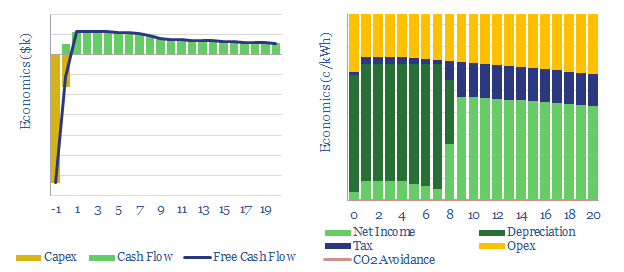
This data-file captures the energy economics of an Organic Rankine Cycle to recover low-grade waste heat (at 70-200C) from an industrial facility, or in the geothermal industry. A CO2 price of $50-75/ton could greatly accelerate adoption and improve the efficiency of industrial facilities.
-
Thermal power plant: loss attribution?
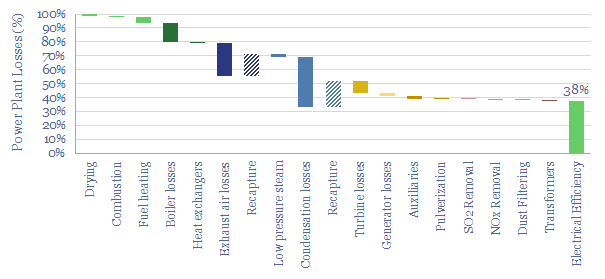
This data-file is a simple loss attribution for a thermal power plant. For example, a typical coal-fired power plant might achieve a primary efficiency of 38%, converting thermal energy in coal into electrical energy. Our loss attribution covers the other 62% using simple physics and industry average data-points.
-
Refrigerants: leading chemicals for the rise of heat pumps?
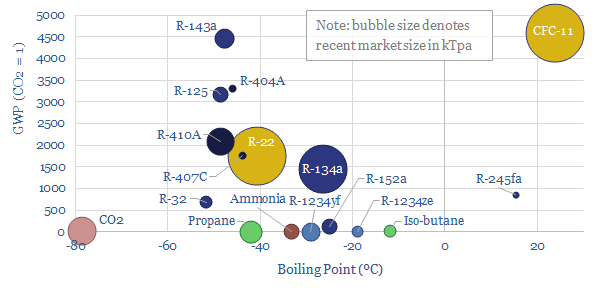
This data-file is a breakdown of c1MTpa of refrigerants used in the recent past for cooling, across refrigerators, air conditioners, in vehicles, industrial chillers, and increasingly, heat pumps. The market is shifting rapidly towards lower-carbon products, including HFOs, propane, iso-butane and even CO2 itself. We still see fluorinated chemicals markets tightening.
-
Geothermal energy: costs and economics?
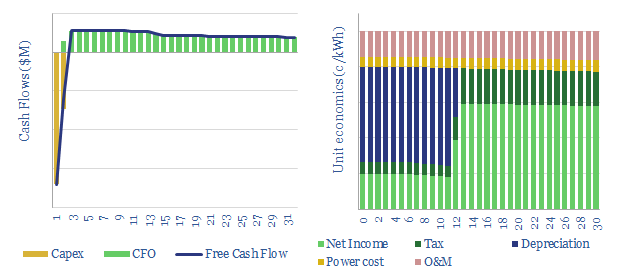
Geothermal energy costs are modelled from first principles in this data-file. LCOEs of 6c/kWh are available in geothermal hotspots. Outside of the hotspots, enhanced geothermal heat can cost 2-14c/kWh-th for a 10% IRR on $500-5,000/kW-th capex, while a rule of thumb is that geothermal electricity costs 5x geothermal heat.
-
Ground source heat pumps: the economics?
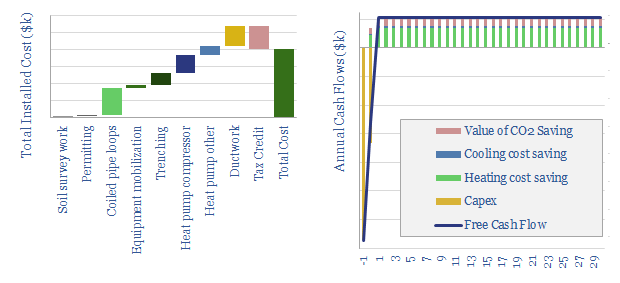
A ground source heat pump approximately doubles the efficiency of home heating and cooling, through heat-exchange with the shallow earth, which remains at 10-15°C temperatures year-round. This data-file captures the cost and CO2 savings.
-
Adiabatic flame temperature: hydrogen, methane and oil products?
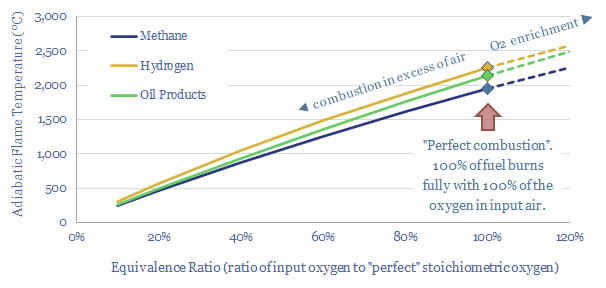
At an idealized, 100% stoichiometric ratio, the adiabatic flame temperature for natural gas is 1,960ºC, hydrogen burns 300ºC hotter at 2,250ºC and oil products burn somewhere in between, at around 2,150ºC. The calculations show why hydrogen cannot always be dropped into an existing turbine or heat engine.
-
Global energy demand by end use?
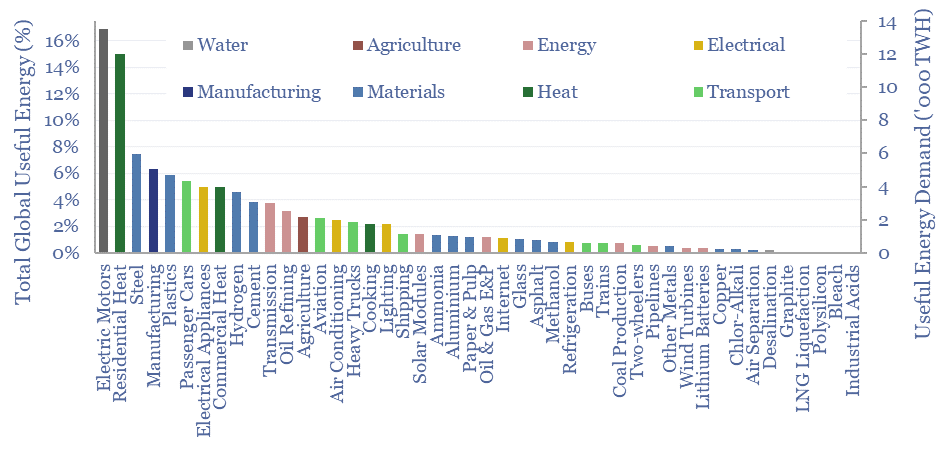
This data-file is a breakdown of global energy demand by end use, drawing across our entire research library, to disaggregate the global energy system across almost 50 applications, across transportation, heat, electricity, materials and manufacturing. Numbers, calculations, efficiencies and heating temperatures are in the data-file.
-
Costs of home heating technologies
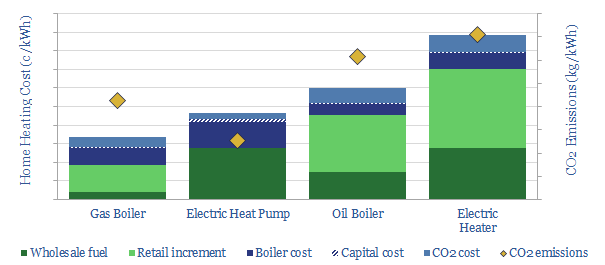
Residential heating will likely cost 5-30c/kWh, with a CO2 intensity of 0.1-0.4 kg/kWh. Gas fired boilers are lowest cost, even after paying $50/ton for carbon offsets. Electric heat pumps are most efficient. Oil furnaces and electric heaters are higher-cost and higher-carbon. The numbers can be stress-tested in this data-file.
-
District heating: the economics?
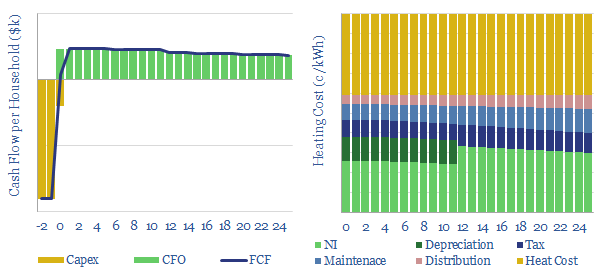
District heating can lower CO2 intensity, by piping waste heat from power generation or industry to consumers. Costs can vary by a factor of 10x. But our base case estimates a 10% IRR at 10c/kWh retail heating price. Please download the model to flex gas prices, household consumption rates or costs.
-
Heat pumps: hot and cold?
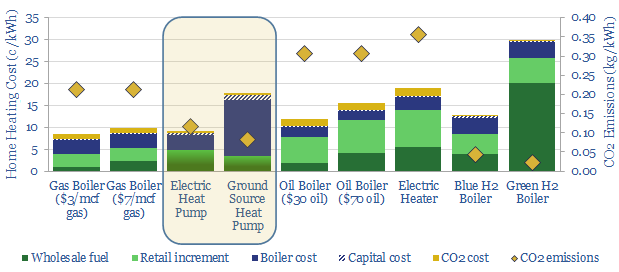
Some policymakers now aspire to ban gas boilers and ramp heat pumps 10x by 2050. In theory, the heat pump technology is superior. But in practice, there are ten challenges. It could become a political disaster. The most likely outcome is a 0-2% pullback in European gas by 2030.
Content by Category
- Batteries (89)
- Biofuels (44)
- Carbon Intensity (49)
- CCS (63)
- CO2 Removals (9)
- Coal (38)
- Company Diligence (95)
- Data Models (840)
- Decarbonization (160)
- Demand (110)
- Digital (60)
- Downstream (44)
- Economic Model (205)
- Energy Efficiency (75)
- Hydrogen (63)
- Industry Data (279)
- LNG (48)
- Materials (82)
- Metals (80)
- Midstream (43)
- Natural Gas (149)
- Nature (76)
- Nuclear (23)
- Oil (164)
- Patents (38)
- Plastics (44)
- Power Grids (130)
- Renewables (149)
- Screen (117)
- Semiconductors (32)
- Shale (51)
- Solar (68)
- Supply-Demand (45)
- Vehicles (90)
- Wind (44)
- Written Research (354)